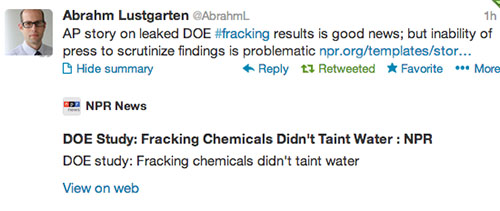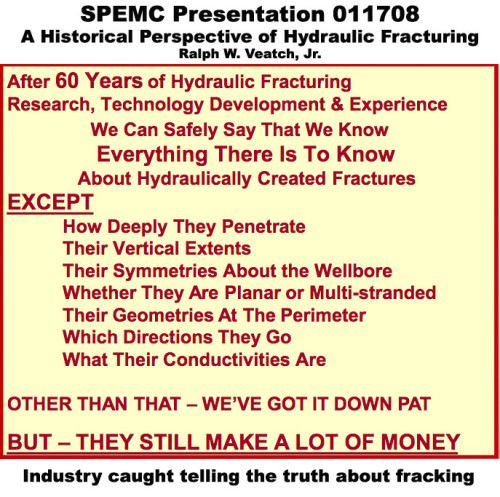
A new “study” of a single, carefully controlled fracking site was released today. It shows that fracking chemicals from that one single, carefully controlled frack site did not contamination any groundwater. Yet. Oh! Oops! A closer read reveals that Begos buried the lead on this story. I’m so surprised that he would do that and that his editors didn’t notice. <insert surprised face>
Seismic monitoring determined one hydraulic fracture traveled 1,800 feet out from the well bore; most traveled just a few hundred feet. That’s significant because some environmental groups have questioned whether the fractures could go all the way to the surface.
The breaking news here is that industry cannot control their fractures as we knew all along and as industry has admitted. The not breaking news is that a single, highly controlled frack job came out okay. I guess this industry statement about fractures: From Schlumberger
Clearly the industry has much to learn about hydraulic fractures.All hydraulic fracture models fail to predict fracture behavior precisely and in many cases, models fail completely
…Was more correct than this industry statement about fractures: Tom Price of Chesapeake Energy says:
“These are surgical operations… (ProPublica)
This “study” used tracers to indicate water contamination. Tracers are not a reliable indicator according to many hydrogeologists. The tracers do not always flow through the formations at the same rate as the other fluids. For that reason, you can get false results using tracers. Also note that someone finally monitored a site through the entire process. Isn’t this the first time ever? I’m pretty sure no one has said that every, single frack job contaminates water. But the fact is that chemicals used in the fracking process have shown up in drinking water. Science needs to either catch up or common since needs to rule. We are dying out here waiting on science to catch up!!! Updated to add tweet of the day:  Alternate titles: BREAKING NEWS: DOE fracking study shows subsurface trespass probable! Out of zone fracks likely! AP Faulty Logic: Drunk driver gets home safely! Drunk driving is safe. One fracking test does not safety make. BREAKING NEWS: After 70 years, government finally decides to test fracking. Updates below:
Alternate titles: BREAKING NEWS: DOE fracking study shows subsurface trespass probable! Out of zone fracks likely! AP Faulty Logic: Drunk driver gets home safely! Drunk driving is safe. One fracking test does not safety make. BREAKING NEWS: After 70 years, government finally decides to test fracking. Updates below:
DOE: Fracks can hit aquifers! A DOE test well in Pennsylvania has proven that a frack can travel up to almost 2,000 feet. Which means that a frack can contaminate an aquifer – if the separation between the two is less than 2,000 feet. Immediately.
About Sharon Wilson
Sharon Wilson is considered a leading citizen expert on the impacts of shale oil and gas extraction. She is the go-to person whether it’s top EPA officials from D.C., national and international news networks, or residents facing the shock of eminent domain and the devastating environmental effects of natural gas development in their backyards.
- Web |
- More Posts(5121)

Fracking is surgical like hitting a glass with a sledgehammer is surgical.
Nice analogy.
The results of this “study” mean only that one frack job in a highly controlled environment seems to have gone okay, so far. Unless they disclose every chemical used and we do follow up testing for every chemical used and all contaminents in the formation that could be loosed, it is meaningless.
Sometimes a drunk driver makes it home safely. Should we allow drunk driving?
“These are surgical operations…”
… performed by people pretending to be surgeons.
“A large kick was recently taken on a well being horizontally drilled for unconventional gas production in the Montney formation. The kick was caused by a fracturing operation being conducted on an adjacent horizontal well. Fracture sand was circulated from the drilling wellbore, which was 670m from the wellbore undergoing the fracturing operation … Fracture fluids introduced into producing wells results in suspended production, substantial remediation costs and pose a potential safety hazard. Incidents have occurred in horizontal wells with separation distances between well bores ranging from 50m to 715m.
Fracture propagation via large scale hydraulic fracturing operations has proven difficult to predict. Existing planes of weakness in target formations may result in fracture lengths that exceed initial design expectations.”
http://www.bcogc.ca/document.aspx?documentID=808&type=.pdf
Can’t control gas migration, can’t control fracs, big ticket items they can’t seem to control – so it would make sense to set out on an unprecedented, “can’t control,” frac-the-world campaign.
“A 1989 peer-reviewed paper reported that ‘hydraulic fracturing stimulation’ for light oil, in several wells in a low permeable sandstone reservoir in southwest Manitoba, propagated into the underlying water zone:
‘Following the unsuccessful stimulation of several wells in the South Pierson field where hydraulic fractures propagated into the underlying water zone, a comprehensive re-evaluation and detailed design effort was implemented to minimize the potential for water production.
… Ideally, the hydraulic fracture created should extend laterally within the zone of interest, however, it is well known that substantial vertical fracture propagation may also occur, significantly impacting the success of the treatment.
Complicating factors such as underlying water zones or overlying gas sections can be easily penetrated and subsequently reduce or eliminate any sought after oil production.'”
http://www.onepetro.org/mslib/servlet/onepetropreview?id=PETSOC-89-05-05&soc=PETSOC
http://www.frackingcanada.ca/industrys-gas-migration/
Like trying to regulate a tornado, all you can really do is stand back and hope like hell it doesn’t take out a community.
At least citizens affected by tornadoes receive help.
Sharon, I just did a little research on your query.
“Sometimes a drunk driver makes it home safely. Should we allow drunk driving?”
100 people surveyed said: “Yes … with strict regulations it could be safe and sustainable.”
I’d like to get the schlumberger report you cite here into the Frack Free Genesee Library, but it is in .ashx format. My mac doesn’t know what to make of that. Can you give me a clue on how to search for this report online? Maybe I can find it in another format. (I tried all the obvious searches already – at least obvious to me).
Thank you for all you do. I’m from Pleasant Grove, Texas, and got out of there as fast as I could. I know it takes grit to do what you are doing.
Here is a pdf of that report: http://bit.ly/17r9Kpv
But I have much more on how industry admits they cannot predict where the heck fractures will go.
Some of this information is old but the industry comments about fractures still applies http://bit.ly/15umfPH
Hydro frack historical view (see somewhere around page 64)
https://www.dropbox.com/s/tqi22o3i946bcjp/Historical%20Perspective-SPEMC-Presentation-011708.pdf
See January 23, 2013, presentation by
Mark K. Boling – President of V+ Development Solutions, Division of Southwestern Energy Company
Balancing Environmental, Social and Economic Impacts of Shale Gas Development Activities
Some of my notes:
Admits fractures go out of zone but says 100% of water contamination is from casing.
o (about 13 minutes in) asses the formation before you start drilling and make sure there is a confining layer “that will prevent the fractures from propagating from the formation up into the underground source of drinking water.” Look at distance between formation and underground drinking water.
o Eval different rock properties in target formation and formations above and below well. “…formations above and below tend to keep those fractures within that formation cause they tend to move in the path of least resistance.”
4. real-time monitoring of frack job and production pressures to detect abnormal pressure responses. (Note: monitoring does not prevent breach in well integrity, it only tells you that the breach has occurred.) Monitoring can tell if fractures are being contained within the formation.
In the new days of shale fracking—–it is VERY difficult (if not impossible) to predict and control the upward propogation of fracking fluids. In these deeper formations the induced fracture is likely to propogate upward, not laterally as in the days of ‘ole. Upward propogation is determined, largely, by the ratio of vertical stress to lateral stress in the earth formation.
see page 64: http://www.scribd.com/doc/151712398/SPEMC-Presentation-011708
That’s a pretty good summary on page 64!
Made me laugh. I love it when we catch them telling the truth.
Nice, thanks ladies.